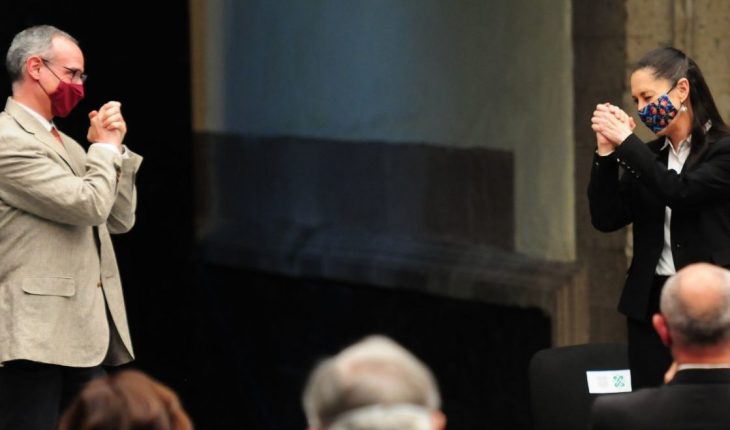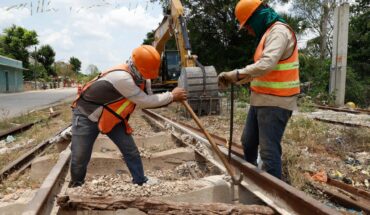Mexico City never reached a crisis over hospitalizations and deaths and stability has already been achieved, and most economic activities are operating, said Claudia Sheinbaum, head of capital government in her report devoted to COVID-19.
Sheinbaum Pardo explained that hospital care in Mexico City had growth, which was never exponential, then a slow drop and for a fortnight shows stabilization.
This is a different situation than in other cities such as New York or Madrid, where there was hospital saturation and then a significant reduction, he said.
Read: Circuses and aquariums in CDMX will resume activities next week
The representative explained that on September 17 she will give her government report, but decided to separate it into two parts and dedicate the first to report on what has been done in Mexico City since February to deal with the pandemic.
In this first part of the report – in which she was accompanied by Officials from Mexico City, and federal officials, such as undersecretary of Prevention and Promotion of Health, Hugo López-Gatell; IMSS CEO Zoé Robledo and Insabi Director Juan Ferrer-Sheinbaum reported on how the stabilization of hospitalizations and deaths in Mexico City has been achieved.
He stressed that if containment work had not been done, the number of hospitalizations in Mexico City would have been 10 times higher.
The highest level of hospital care was presented in May (between 18 and 24 with between 4 thousand 540 total hospitalizations daily and 4 thousand 448), then began to decrease in mid-June (with 4 thousand 279) and for three weeks to date there is a stabilization (with between 2 thousand 941 and 2 thousand 868).
Emergency calls to 911, Sheinbaum said, have increased from 400 or 600 a day in May to 65 today.
The same is seen, he said, in indicators of excess mortality (deaths that exceed what was expected compared to previous years). Although of this, the head of government noted that an accurate report will be made in the following days.
Find out: Give new list of colonies with more COVID and priority attention in CDMX
But it went ahead that in May (in the middle of that month according to the graph it presented) there was a spike in excess of deaths, in June the decline began and now there is a stabilization.
Stocks
Sheinbaum highlighted the actions that have been undertaken in Mexico City to contain the epidemic. He spoke of the Epidemiological Model for Mexico City, with the collaboration of researchers and developed by the Digital Agency for Public Innovation.
“You had (in this model) a pessimistic scenario, a more controlled one and (the latter) behaved practically like reality. It is in the last 15 days that it is being oversized (the pessimistic scenario that was considered for these dates), but it is because of the reopening of a lot of economic activities, and yet we have had no outbreaks, there is a controlled situation,” he said.
On several occasions, the head of government stressed that Mexico City never slid, the airport and bus terminals were not closed, sick people who needed hospital care were received, and no punitive measures were put in place to restrict mobility, although the use of the water cover was advised, she stressed.
She also stressed that control of the epidemic was achieved even though more than 50% of the population lives a day and finds it difficult to stop going to work.
He also said that at first there were problems for the health personnel of the hospitals in Mexico City to have their protective equipment, but then this became normalized. “Every day we saw who had fans, with personal contact, to see what situation they were in and how to deal with the most difficult times.”
A remote medicine system was created, he explained: the SMS system that since 23 March was available and which has served 811,082 users, with 595,534 completed screenings, 150 doctors and 2,097 telemedicine consultations.
Read: CDMX stays orange; app for COVID test results
The Responsible and Protected Homes Program was also developed, in which 47,311 families have received support: composed of a medical and feeding kit, a card with a thousand pesos and communication with Locatel doctors; everything so they can be home for 15 days.
So far, Sheinbaum said, about 400 to 500 kits are still delivered daily.
Regarding hospital conversion, he said it went from 30 hospitals to 58, in a first phase, and then to 117 hospitalsit is for the care of COVID patients and climbed from 4 thousand 435 general beds to 7 thousand 133; as well as 539 intensive care beds at 2 thousand 659. In addition, more than a thousand health workers and 650 were hired to strengthen the Temporary Unit of Citibanamex and that of IMSS (at the Autodromo Hermanos Rodríguez).
In total, 338 thousand 943 tests have been done in the City, he said.
He also reported that there is a strategy to deal with deaths, in which a thousand 750 free funeral services have been given to family members and have been guided so that they have no problem finding a funeral home.
On what he called props to the most vulnerable, he stated that CDMX basic education students were deposited with 500 more pesos for three months, in addition to My Scholarship to Get Started.
In addition, other supports such as credits have been granted to 100,000 people, dedicated to taxi service and the Tianguis. And, through the mayoralties, the Mercomuna programme has been operated, to encourage consumption within the premises of the same demarcations.
Since the CDMX entered orange at the Risk Traffic Light, the COVID-19 Case Detection, Protection and Safeguarding Program and its Contacts were implemented, seeking initial, pre-hospital care and the location of positive people and their contacts to prevent further spread of contagion.
This program started with phone calls from Locatel and public servants and has been expanded, first to 38 colonies and today to 158.
75,000 calls have been made to positive cases, 52,000 answered, 38 thousand who were given the epidemiological questionnaire, and 8,000 people who agreed to give contacts, giving at least a total of 16,000 people served to prevent them from generating more contagion.
Sheinbaum also reported on the Early Care Program, in which the National Institute of Nutrition participates, to remotely train general physicians who serve in private pharmacies.
To locate cases, the head of government stated that there are days that 6 thousand tests are done daily, although in the highest days up to 50 thousand have been done. “But the tests are accompanied by the support kits, with communication with a doctor, if necessary they are visited at home, because the tests alone do not work.”
So far, specific to the head of government, it has dropped from a positivity, in May, from 54% (out of every 100 people who are tested 54 were positive) to 25%, “and the economy is open, we achieve this with this joint and permanent work of daily monitoring”. While the decline in decesses, Sheinbaum attributed it to the therapeutic care that has been found, but did not need more about it, and the entire system of information and support for vulnerable people.
To top it off, he said that the CDMX did target the use of water cover and that the Priority Colony Program went from 38 to the beginning to 158.
In this program, he explained: “you get to the colony, it is filled with posters, you perish, you put on health kiosks, you give orientation to the population, you see if they have comorability and after a screening they are tested, if they are positive, they are visited at home and Locatel calls them every day to see how they are and what they need.”
In addition, Sheinbaum stated that the Health System was designed in your life for the care of people with diabetes and hypertension. He also noted that, together with the National Institute of Nutrition and international institutes, a number of medicines are being tested, of which Cofepris has already approved its protocol.
What we do at Animal Politics requires professional journalists, teamwork, dialogue with readers and something very important: independence. You can help us keep going. Be part of the team.
Subscribe to Animal Politics, receive benefits and support free journalism.#YoSoyAnimal
translated from Spanish: CDMX managed to stabilize COVID pandemic: Sheinbaum
September 14, 2020 |





